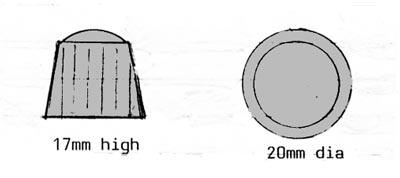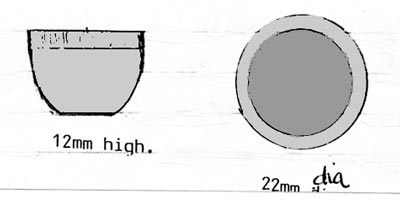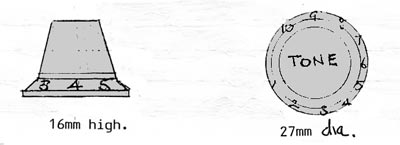

Electrics Generally
Hofner offered wide-ranging options on the guitars distributed by Selmer. These comprised anything from a single pick-up and controls to complex multi-switching facilities; a notable example being the stereo version of the Verithin model. I have not attempted to cover the complex arrangements but only the basic electrics available on the archtop and semi-solid guitars.
The various types of pick-up used by Hofner are more than adequately covered by Stephen Candib on his Web Site and also by Michael Naglav in his book on Hofner guitars. Gordon Giltrap also touches on these in his book "The Hofner Guitar". There is a section on pickups on Steve Russell's Hofner Website
According to Selmer’s catalogue of 1966, the Ambassador guitar was available with standard staple-top pick-ups, or alternatively with De Armond pick-ups. To the best of my knowledge, this was the only UK Hofner on which these American pick-ups were available. Detailed below are the standard types used by Hofner.
Type 1:
Ebony or rosewood body with Trepholite capping, or all bakelite body (1955-1959)
Fig 5-1: Type 1 Pickup
Type 2:
Chrome-plated metal enclosed casing; four black recesses; Hofner diamond logo; plastic frame (1960).
Fig 5-2: Type 2 Pickup
Type 3
Chrome-plated metal enclosing; rhombus with Hofner logo inside; plastic frame (1961).
Fig 5-3: Type 3 Pickup
Type 4 (Hofner Model 510)
Chrome-plated metal enclosed casing; six adjustable screws; plastic frame (1961-1962).
Fig 5-4: Type 4 Pickup
Type 5 (Hofner Model 510)
Chrome-plated metal enclosed casing; six adjustable screws; rhombus with Hofner logo inside; plastic frame (1962-1963).
Fig 5-5: Type 5 Pickup
Type 6 (Hofner Type 511)
Chrome-plated metal enclosed casing; six adjustable screws; six staple magnets; plastic frame (1963-1967).
Fig 5-6: Type 6 Pickup
Type 7 (Hofner Type 513)
Chrome-plated metal enclosed casing; continuous bar magnet; six adjustable screws; plastic frame (1967-1978).
Fig 5-7: Type 7 Pickup
Hofner also produced separately marketed pick-ups that could be fitted to ostensibly acoustic instruments. Such pick-ups varied from simple neck-fitting units to those having combined pick-up, scratchplate and separate tone and volume controls.
Type 1 Control Panel
The first generation of control panels comprised a circular base-plate of tortoiseshell with white edging, two or four knobs; the four knobs mounted in a diamond-style formation for treble and bass control. The four knobs were normally accompanied by two flick-switches; one for treble and one for bass. The flick-switches were located on the left side of the control panel. The flick-switches were not used on the two knob units, these control panels were only incorporated in the early guitars in or around 1955 to 1958.
Fig 5-8 Control Panel 1955 to 1958
Type 2 Control Panel
The second type used was the more familiar layout as featured on the Beatle-bass for example (Type A2 in Hofner’s catalogue). This layout consisted of a rectangular base-plate once again in tortoiseshell edged in white or alternatively pearloid edged in black. The back plate was 100mm x 30mm, or 85mm x 30 mm depending whether double or single pick-ups were employed. The layout of the panel comprised one or two rotary knobs for volume, three slider switches, two of which turned each pick-up on or off. The third switch entitled Rhythm/Solo provided a preset 70% reduction in the set volume. The units have "DGMang" stencilled on bottom right-hand corner.
The second type of control panel was used by Hofner from 1958 to 1962 when the more simple individual rotary control were employed. These rotary units were calibrated on the skirted-rim and had "Volume" or "Tone" engraved on nickel-plated inserts.
Hofner sales literature for the period described these rectangular layouts as "Double-Plate Flick-Action Consoles". Very technical stuff!
Detailed in figure 5-9.
Fig 5-9: Control Panel 1958 to 1962
The four controls on the two pick-up guitars, were laid out in a trapezoidal pattern, all as per Gibson guitars. On the single pick-up models, the controls were positioned left of the treble sound hole.
A flick switch was installed on Committee guitars from about 1963, located on the upper bass bout. This switch enabled either neck or bridge pick-up to be used independently or alternatively or both simultaneously.
Around 1965, Hofner had a change of design. The four controls were now reduced to three, set in a diagonal formation towards the bridge. Simultaneously, the flick switch was placed on the treble upper bout.
Around 1967, the switch was returned to the bass bout.
Detailed below, are the knob types normally found on Hofner guitars. Any departure from these will be non-original.
Type 1 (circa 1955)
Employed on the first of the Selmer Hofners. Self coloured cream. Ribbed in uniform pattern all round with a reduced diameter on lower section.
Fig 5-10: Control Knob Type 1
Type 2 (circa 1958/1959)
This type appears to have been used for a relatively short time as I have not come across these on many guitars. The knobs are generally cream in colour., heavily ribbed for full height with gold engraved dome shaped inserts. The mounting holes are brass lined.

Fig 5-11: Control Knob Type 2
Type 3 (circa 1956/1962)
This is the most common variety found on Hofner guitars. They are cup shaped, lightly ribbed on upper edge with gold concave inserts. Two versions of such knobs were available, one with rounded top lip and one with bevelled top lip.

Fig 5-12: Control Knob Type 3
Type 4 (1962 onwards)
Rotary style, sombrero pattern, calibrated on skirt 1 to 10. Off white in colour. Nickel or plastic inserts with deeply etched Tone or Volume. On Committee guitars, RH for Rhythm and S for Solo are used.

Fig 5-13: Control Knob Type 4
Three types are normally found on Hofner guitars.
The originals were manufactured by Kolin. These comprise round grey metal pots on ornately shaped baseplates and have 50 stamped on the base. The baseplates, have projecting bakelite plates on which are projecting lugs. (see wiring diagrams)
The second generation have round pots, battleship grey in colour with square brown baseplates. The baseplates have three vertically protruding lugs and four corner plates for earthing purposes.
According to some sources, the year of production can be confirmed by a simple coding system printed on the baseplate. The date codes, usually have three numbers( 305 for example relates to the thirtieth week of 1965. The pots have a standard resistance of 250k.
A revised pot was introduced around the mid 1960s. This variety had silvered round pots with three horizontally projecting square lugs. The introduction of this pot seemed to go hand in hand with a more simplified wiring system. (see section on wiring diagrams)
The design of these, would appear to have remained virtually unchanged during their period of use (1959 - 1962)
This section relates purely to the wiring between pick-ups and control panels.
Wiring used in the early 1950s comprised of a braided outer sheathing with black and or white inner sheathing and solid single strand copper wire.
From the late 1950s the wiring comprised a black outer sheathing with dark green inner sheathing to both live and screening wires.
From about 1960, light grey outer sheathing was used, with the live wire having white inner sheathing . The copper screening wire was now uncovered. This type of wiring appears to have been adopted till around 1970.
© Ramsay McKinnon 2006.